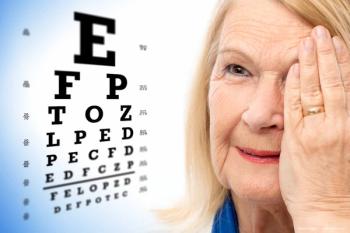
- Ophthalmology Times Europe December 2024
- Volume 20
- Issue 10
- Pages: 8 - 11
Shining new light on ocular surface care
Low-level light therapy for dry eye disease and chalazion
Light therapy is demonstrating an increasingly important role in eye care. Optometrists have traditionally been the experts in treatment with light through a mastery refraction. Many of our patients benefit from us refracting light to optimally focus images on the retina. But in recent years, we have leveraged our understanding of how light wavelengths and light intensity can be used to manage conditions regarding the health of the ocular surface. Specifically, low-level light therapy (LLLT) and intense pulsed light have demonstrated tremendous benefits for our patients.
Understanding the skin
The skin is a complex organ that plays an important role in human physiology. It is composed of the epidermis, the dermis and hypodermis. The epidermis is the outermost layer of the skin and lies directly over the dermis. The dermis is the middle layer of the skin. The hypodermis is directly below the dermis and connects the skin to underlying fat and muscle tissue.1
The epidermis is composed of five layers that include different cells. At the innermost portion of the epidermis, basal cells continually replicate and replace the other cells of the epidermis. From the basal layer of the epidermis to the most superficial layer are: 1) the stratum basale, 2) the stratum spinosum, 3) the stratum granulosum, 4) the stratum lucidum and 5) the stratum corneum. The epidermis replaces itself every 28 to 42 days.2,3
The dermis is the layer of the skin beneath the epidermis. The hypodermis provides structural and nutritional support for the overlying epidermis. Within the dermis are collagen, elastic tissue and other extracellular components that include vasculature, nerve endings, hair follicles and glands. Fibroblasts are the primary cell type in the dermis.4 Normally, the vascular supply is not visible when viewing the skin of the face; however, when there is inflammation in the skin, the blood vessels can dilate and be visible.5
Over time, the collagen in the dermis can become less structured, which leads to skin laxity. Additionally, the elastin fibers also lose their elastic properties. These changes can be seen over time on the face and around the eyes, as wrinkling occurs in the skin around the eyes.6 The blood supply in the face is not distinctly separate from the vascular supply of the eyelids. As such, inflammatory conditions that affect the skin can also affect the eyelids and eyelid margin.7 With the thin skin on the eyelids and the close proximity of the meibomian glands, this can often affect the health of the meibomian glands.8
Inflammation of the skin can occur through a variety of mechanisms. Through the process of inflammation, cytokines and chemokines are released into the dermis, which spurs the recruitment of inflammatory cells and leads to vessel dilation and warming of the surrounding tissue. Unfortunately, this process often cascades and is poorly controlled, leading to additional inflammation.7,8
Light and how it affects the skin
We need only to think about excessive exposure to UV radiation to understand the effect and power that electromagnetic radiation can have on the skin, demonstrated by tanning, sunburns and aging effects.9,10 Electromagnetic variance can produce very different effects when the skin is exposed to it. One key factor that determines this is the wavelength the skin is exposed to. In general, longer wavelengths will penetrate the skin at greater depths.11
UV radiation has a wavelength between 100 nm and 400 nm and penetrates the skin the least. UVA is between 315 nm and 400 nm and is not visible. UVB, also not visible, is between 280 nm and 315 nm. UVC is below 280 nm and is filtered out in the atmosphere, never reaching us. Although UV radiation can penetrate the skin, it does so at a very shallow depth.11 UVA typically causes the oxidative stress associated with aging and will break down collagen, enhancing the aged skin appearance. UVB, which is lower in wavelength, is absorbed in the epidermis. When the skin is exposed to low quantities of UVB, it increases melanin in the epidermis, creating what we typically refer to as a suntan. Excessive exposure to UVB can cause sunburn. Excessive exposure to UVB can also cause DNA mutation in the skin and can ultimately lead to skin cancer.12
It is evident that electromagnetic radiation can affect the skin in a variety of ways. UV radiation is outside the visible spectrum and penetrates the skin at very shallow levels. As we consider longer wavelengths of electromagnetic radiation, they have different properties that allow them to penetrate the skin at increasing depths. As you increase the electromagnetic radiation from the UV range, you enter the visible spectrum, and the wavelengths between 400 nm and 700 nm are within the visible range.
Exposing the skin to increasing wavelength allows for deeper penetration of light into the skin. Blue light (440 nm) has less penetration depth than red light (650 nm). Infrared light (750 nm) has the greatest penetration in the skin. Blue light will have very little penetration in the dermis, whereas both red and near-infrared light have been estimated to reach depths of 4.5 mm and 5.5 mm, respectively, in the skin.11 This depth allows for interaction with the cells and other structures within the dermis, which will impact properties of the skin, such as collagen content, elasticity and cellular function.13
LLLT can cause changes to tissue structure and function by its influence at a molecular and cellular level. Cytochrome C oxidase (CCO) is an enzyme located in the mitochondria of cells that acts as a chromophore for red and near-infrared light. Absorption of this light energy by CCO enhances enzymatic activity, mitochondrial respiration and adenosine triphosphate (ATP) production.13 Additionally, LLLT can alter transcription properties within the cell.13
Tissue changes result directly from these intracellular changes, along with nonspecific changes to the skin. LLLT has been shown to increase production of procollagen, collagen, basic fibroblast growth factors and proliferation of fibroblasts.13 Tissue inhibitors of metalloproteinases are also elevated in tissues treated with LLLT and likely protect newly synthesised collagen from proteolytic degradation of matrix metalloproteinases.13
LLLT and the eyes
With the metabolic and structural changes occurring in skin exposed to LLLT, the question then becomes what the effect may be for individuals with dry eye disease. The restorative processes of LLLT in the skin are likely the reasons for the improvements seen to ocular surface physiology. The eyelid skin is the thinnest in the body, likely augmenting its therapeutic effects.
There was an interesting study looking at the effects of eyelid temperature after treatment with LLLT. Investigators randomly assigned study participants to either a sham control, LLLT treatment for 15 minutes, or a commercially available heat mask for 10 minutes. External and internal upper and lower eyelid temperatures were measured using a thermal camera immediately after exposure to either of the treatments or sham control. Both treatment groups demonstrated increased temperatures in all eyelid regions measured compared with the sham control group.14 The LLLT temperature elevation may lead to some of the therapeutic effects seen with patients undergoing LLLT for dry eye disease.
Our understanding of LLLT, its effects on the skin and its thermal effects on the eyelids has been supported with the role it plays in managing dry eye disease. In a recent study, patients had three LLLT treatment sessions, each session separated by a week. Participants were examined at baseline and 4 weeks later. The data demonstrated improvements in noninvasive keratograph tear break up time, tear meniscus height, tear film lipid layer thickness, Schirmer test score and Ocular Surface Disease Index score. The data also demonstrated external upper and lower eyelid temperature elevation.15
In a randomised-control clinical trial, investigators randomly assigned patients to receive LLLT twice a week for 3 weeks or sham treatment. The primary end point was corneal staining, which was reduced at a statistically significant level in patients treated with LLLT compared with placebo. Secondary end points with statistically significant improvements in the LLLT group were lissamine green conjunctival staining and Schirmer test score.16
The influence of the ocular surface has become increasingly important with surgical patients. Patients scheduled to undergo cataract surgery received LLLT
7 days before surgery and then additional LLLT 7 days after surgery and were compared with a sham control group that did not receive treatment. Outcomes were measured 30 days after cataract surgery. Patients treated with LLLT had lower Ocular Surface Disease Index scores and improved noninvasive tear film break 30 days after their surgery, demonstrating the benefits of LLLT for these patients.17
In addition to improving tear film and ocular surface function, evidence now exists supporting LLLT for chalazion treatment. Patients frequently seek out alternatives to surgical removal, and this may provide a viable option. In data from a recent retrospective study, 26 eyes of 22 patients with a previous history of failed chalazion treatment underwent a single 15-minute LLLT session, with 46% of eyes demonstrating resolution. Those whose eyes did not resolve received a second 15-minute LLLT. After the second treatment, 92% of eyes experienced resolution of chalazia.18
Our understanding of electromagnetic radiation in the form of LLLT is transforming the way we care for patients. Through actively incorporating this technology in our practices we can help patients in a multitude of ways. Understanding how we can harness the power of light for better patient outcomes will ultimately benefit the patient and the practice.
Case in point: Dry eye
A 52-year-old female patient came into the office complaining that her contact lenses were becoming increasingly difficult to wear comfortably. She was wearing daily disposable contact lenses on a part-time basis because of the comfort issues. The patient filled out a Standard Patient Evaluation of Eye Dryness (SPEED) questionnaire, with a score of 17.
Upon examination she had a tear film break up time of 2 seconds OU and mild corneal staining inferiorly. She had no gland obstruction with mild obstruction and had modest amounts of telangiectatic blood vessels along the eyelid margin, with accompanying telangiectasia on the cheeks and face.
The patient had six LLLT treatments, with each treatment separated by 1 week. I saw her 1 week after the final treatment. She reported being able to wear her contact lenses much more comfortably. Her SPEED score was 5, demonstrating a significant improvement in vision.
The tear film improved to 6 seconds OU, and there was no corneal staining. All the meibomian glands were yielding liquid secretions. Additionally, eyelid margin telangiectasia and facial telangiectasia had both improved (Figure 1). Also, some fine lines were reduced in appearance temporal to the lateral canthus in each eye (Figure 2).
Case in point: Chalazion
A 12-year-old male patient had a history of stye on the upper and lower eyelid of the right eye and one on the lower eyelid of the left eye. He had been applying warm compresses to his eyes several times a day. Additionally, he presented with symptoms of itchy eyes with frequent crusting along the eyelid margin. The stye on the left lower eyelid developed in fall 2023, and had come and gone for about 4 months.
When the patient presented to our office, there was a small chalazion on the upper and lower right eyelids and a relatively large chalazion on the inferior left eyelid (Figure 3). Grade 3 collarettes were at the base of the lashes of each eye (Figure 4).
We prescribed lotilaner ophthalmic solution 0.25%, with instructions to administer one drop twice daily in each eye for 6 weeks to eliminate what we believed to be the underlying etiology of the development of the hordeolum and resultant chalazia. Additionally, we had the patient perform three sessions of LLLT separated by 2 to 4 days. I saw him again 1 week after the last LLLT treatment. The patient came in with the presence of collarettes but the chalazia were completely resolved (Figure 3). I saw him 2 months after he had gone through the 6-week treatment with lotilaner 0.25%, with complete resolution of the collarettes at the base of the lashes.
References
1. Lopez-Ojeda W, Pandey A, Alhajj M, Oakley AM. Anatomy, skin (integument). In: StatPearls [Internet]. StatPearls Publishing; 2022-. https://www.ncbi.nlm.nih.gov/books/NBK441980/
2. Muse ME, Shumway KR, Crane JS. Physiology, epithelialization. In: StatPearls [Internet]. StatPearls Publishing; 2023- https://www.ncbi.nlm.nih.gov/books/NBK532977/
3. Sandby-Møller J, Poulsen T, Wulf HC. Epidermal thickness at different body sites: relationship to age, gender, pigmentation, blood content, skin type and smoking habits. Acta Derm Venereol. 2003;83(6):410-413. doi:10.1080/00015550310015419
4. Brown TM, Krishnamurthy K. Histology, dermis. In: StatPearls [Internet]. StatPearls Publishing; 2022-. https://www.ncbi.nlm.nih.gov/books/NBK535346/
5. Addor FA. Skin barrier in rosacea. An Bras Dermatol. 2016;91(1):59-63. doi:10.1590/abd1806-4841.20163541
6. Lee YI, Choi S, Roh WS, Lee JH, Kim TG. Cellular senescence and inflammaging in the skin microenvironment. Int J Mol Sci. 2021;22(8):3849. doi:10.3390/ijms22083849
7. Tavassoli S, Wong N, Chan E. Ocular manifestations of rosacea: a clinical review. Clin Exp Ophthalmol. 2021;49(2):104-117. doi:10.1111/ceo.13900
8. Machalińska A, Zakrzewska A, Markowska A, et al. Morphological and functional evaluation of meibomian gland dysfunction in rosacea patients. Curr Eye Res. 2016;41(8):1029-1034. doi:10.3109/02713683.2015.1088953
9. Gromkowska-Kępka KJ, Puścion-Jakubik A, Markiewicz-Żukowska R, Socha K. The impact of ultraviolet radiation on skin photoaging – review of in vitro studies. J Cosmet Dermatol. 2021;20(11):3427-3431. doi:10.1111/jocd.14033
10. Matsumura Y, Ananthaswamy HN. Toxic effects of ultraviolet radiation on the skin. Toxicol Appl Pharmacol. 2004;195(3):298-308. doi:10.1016/j.taap.2003.08.019
11. Ash C, Dubec M, Donne K, Bashford T. Effect of wavelength and beam width on penetration in light-tissue interaction using computational methods. Lasers Med Sci. 2017;32(8):1909-1918. doi:10.1007/s10103-017-2317-4
12. Salminen A, Kaarniranta K, Kauppinen A. Photoaging: UV radiation-induced inflammation and immunosuppression accelerate the aging process in the skin. Inflamm Res. 2022;71(7-8):817-831. doi:10.1007/s00011-022-01598-8
13. Avci P, Gupta A, Sadasivam M, et al. Low-level laser (light) therapy (LLLT) in skin: stimulating, healing, restoring. Semin Cutan Med Surg. 2013;32(1):41-52.
14. Antwi A, Nti AN, Ritchey ER. Thermal effect on eyelid and tear film after low-level light therapy and warm compress. Clin Exp Optom. 2024;107(3):267-273. doi:10.1080/08164622.2023.2206950
15. Antwi A, Schill AW, Redfern R, Ritchey ER. Effect of low-level light therapy in individuals with dry eye disease. Ophthalmic Physiol Opt. 2024;44(7):1464-1471. doi:10.1111/opo.13371
16. Park Y, Kim H, Kim S, Cho KJ. Effect of low-level light therapy in patients with dry eye: a prospective, randomized, observer-masked trial. Sci Rep. 2022;12(1):3575. doi:10.1038/s41598-022-07427-6
17. Giannaccare G, Rossi C, Borselli M, et al. Outcomes of low-level light therapy before and after cataract surgery for the prophylaxis of postoperative dry eye: a prospective randomised double-masked controlled clinical trial. Br J Ophthalmol. 2024;108(8):1172-1176. doi:10.1136/bjo-2023-323920
18. Stonecipher K, Potvin R. Low level light therapy for the treatment of recalcitrant chalazia: a sample case summary. Clin Ophthalmol. 2019;13:1727-1733. doi:10.2147/OPTH.S225506
Mile Brujic, OD, FAAO | E: [email protected]
Articles in this issue
12 months ago
Putting diagnostic accuracy to the test12 months ago
Diabetic eye disease: Where are we now?about 1 year ago
Adapting our understanding of cerebral visual impairmentabout 1 year ago
Ethnic background has an impact on glaucoma outcomesNewsletter
Get the essential updates shaping the future of pharma manufacturing and compliance—subscribe today to Pharmaceutical Technology and never miss a breakthrough.















































